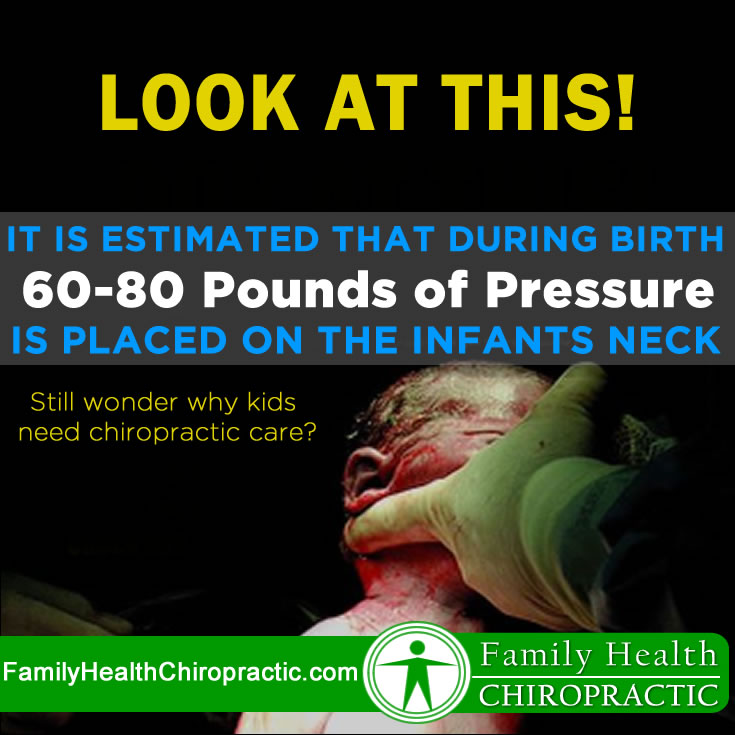Ever wonder why babies need chiropractic care?
In 1992, the Journal of Manual Medicine published a critical piece of information helping us to understand why infants and children need chiropractic evaluations and care. The study evaluated more than 600 children, all less than 2 years of age. In this research they refer to the vertebral subluxation or misalignments of the spine as a “kinematic imbalance due to suboccipital strain” (KISS). The report talked about the pathogenic importance of asymmetric posture in small children and the fact it is often played down — if recognized at all by the medical community. (YOU AND YOUR FAMILY NEED TO UNDERSTAND THIS!)
The authors noted that KISS (misalignments of the spine) have a wide range of clinical signs and in many cases can be dealt effectively with manual therapy. The risk factors for why these children had KISS syndrome, as they called it, were from intrauterine misalignment (misalignments from the mother), application of extraction aids in delivery (the use of forceps, suction, and excessive pulling from the doctor), prolonged labor, and/or multiple fetuses. (BIRTH is the Cause!)
This study is one that definitely offers PROOF AS TO WHY INFANTS AND KIDS NEED CHIROPRACTIC!
 If you ever have anyone ask you if and/or why kids need to be adjusted please make a copy of this study for them!
If you ever have anyone ask you if and/or why kids need to be adjusted please make a copy of this study for them!
Biedermann H. “Kinematic imbalances due to suboccipital strain in newborns” J. Manual Med (1992) 6:151-156.
All scientists agreed that the symptoms of KISS or subluxations found in newborns can include:
torticollis, unilateral face asymmetry, C-scoliosis, motor asymmetries, unilateral retarded maturation of hip joints, slowed motor development, sleeping disorders, neck sensitivity, face swelling, fever of unknown origin, loss of appetite, feet deformities, pathological reflexes, range of motion diminished by 30% or more, and parent reporting baby does not eat or drink well.
They concluded that on these babies “an A-P radiograph of the upper cervical spine is imperative.” The radiograph evaluation helps to find malformations and aids in determining the direction of the adjustment. THERE WAS NO CORRELATION BETWEEN EXTENT OF THE ASYMMETRY AND THE SYMPTOMS OR SUCCESS OF THE TREATMENT! This means that even a small subluxation is clinically relevant.
The treatment involved an “impulse adjustment” and in most cases the direction and line of drive was determined by radiological findings (85% of the time).
6 MAJOR TAKE AWAYS FROM THE STUDY:
1) “Selection of the direction of adjustment without x-ray seems the most plausible cause of the less encouraging results of some colleagues.” This means x-rays helped get better results. Interesting!
2) THE RISK OF TREATMENT WAS MINIMAL! No serious complications were encountered. Most children would cry for a moment but stop as soon as they are in their mother’s arms. In 2 cases (out of roughly 600) the children vomited after the adjustment but had no negative effect of outcome in either case.
3) It was noted that the UPPER CERVICAL SPINE REMAINS A WEAK SPOT IN MOST CHILDREN which is why they should be re-examined before they start school at age 6.
4) KISS is not confined to local complaints or even mechanical symptoms and is not taken into account when these children show signs of restlessness and concentration difficulties. DO YOU HEAR THAT? SUBLUXATION MAY NOT HAVE SYMPTOMS AND UNFORTUNATELY FOR KIDS WITH ISSUES SUCH AS RESTLESSNESS AND ATTENTION ISSUES, THE SUBLUXATION IS TYPICALLY NOT CONSIDERED TO BE A CAUSE.
5) KISS DOES NOT ALWAYS LEAD TO CLINICAL SYMPTOMS! The author noted that babies with a contracted sternocleidomastoid muscle (torticollis) should not be subjected to operative measures to lengthen the muscle because they will nearly always respond perfectly to “adjustment of the upper cervical spine”.
6) Upper cervical “delicate structures undergo considerable stress during delivery” and during delivery “a majority of newborns suffer from micro-trauma of the brain stem tissues in the periventricular areas.” (The CAUSE is “Normal” Births) ***Another interesting side-note from this study was that the adjustment of the occipital/cervical region led to disappearance of problems that the parents had not reported because they did not see a connection with the spine. (I CAN'T TELL YOU HOW MANY TIMES WE HEAR THIS IN PRACTICE?) And these parents would regularly note that their child would eat or sleep much better since the treatment.
WHO NEEDS TO KNOW ABOUT THIS? EVERYONE!
References:
Biedermann H. “Kinematic imbalances due to suboccipital strain in newborns” J. Manual Med (1992) 6:151-156.


 If you ever have anyone ask you if and/or why kids need to be adjusted please make a copy of this study for them!
If you ever have anyone ask you if and/or why kids need to be adjusted please make a copy of this study for them!
